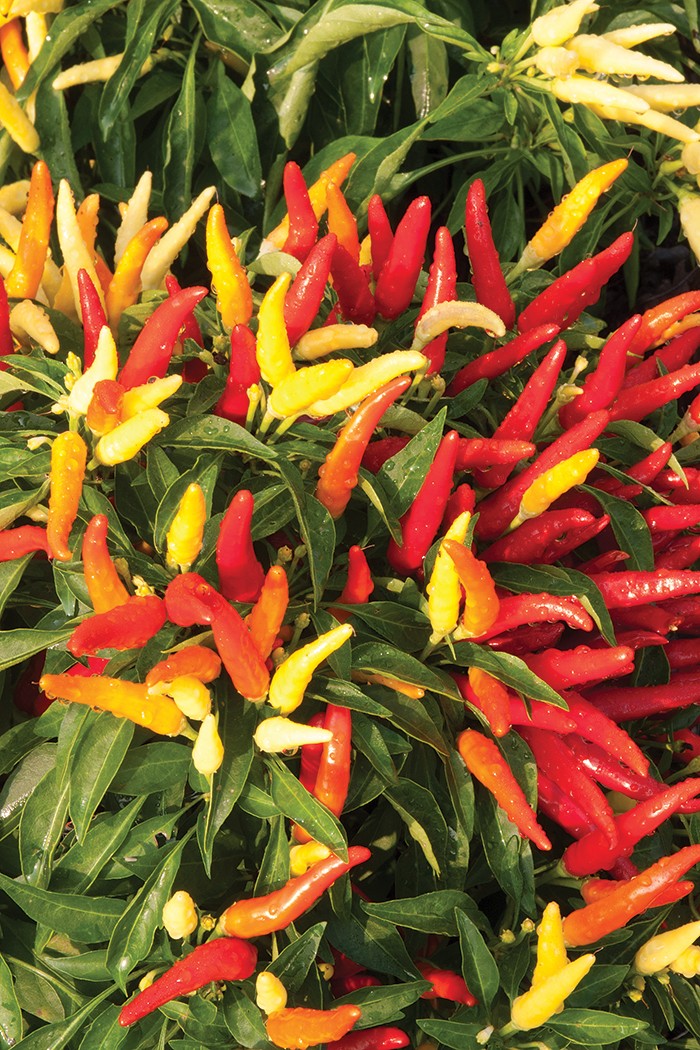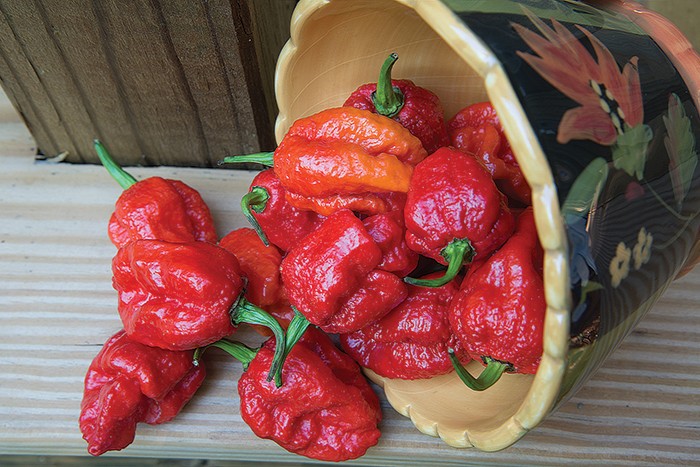When it comes to peppers, many adventuresome gardeners seek out the hottest of the hot. The temptation draws them like moths to flames, and possessing a pepper with such ultimate scorch equates to having a rock star growing in the veggie patch.
Currently, the pepper that resides on top of the molten heap is ‘Carolina Reaper,’ which, as its name implies, has regional roots. Conjured up by Ed Currie from PuckerButt Pepper Company in Fort Mill, S.C., this introduction is like backyard-grown lava.
How hot is ‘Carolina Reaper’? Let the Scoville Scale, which measures the pungency in peppers, be your guide. Starting at the bottom, sweet bell peppers barely reach 100 units, while the popular jalapeno comes in at around 10,000. And although the habanero pepper has been a ruling burning brute for years with rates upwards of 350,000 units, ‘Carolina Reaper’ easily nukes it by averaging around 1,600,000 units. That’s crazy hot.
In spite of its blazing bite, I think ‘Carolina Reaper’ is a rather pretty plant. Growing just over 2 feet tall and about as wide, this pepper’s rich green foliage sets a perfect backdrop for the dangling dazzle of fruits that are dark — some say ominous — orange to devilish red in color, and oddly attractive, although crinkly and pudgy-looking.
And there will be a lot of dazzle. Of the five different peppers I grew last year, ‘Carolina Reaper’ was the one constantly full of fruits, and its strong show continued until the first killing frosts.
Now, let me make one thing clear: Be careful with ‘Carolina Reaper.’ Don’t pop one of the fruits into your mouth and chomp down to see how it tastes — because, if you do, your day’s gonna be different. And don’t slip a piece of this pepper into a friend’s salad or sandwich as a joke, because he or she isn’t going to find it funny.
Somewhere in all of its heat, ‘Carolina Reaper’ does have a sweet, fruity flavor, so start with a sliver of one fruit to jazz up stews, soups, salsas or hot sauces, and then you can adjust this pepper’s portions after finding your tolerance to its sizzle.
‘Carolina Reaper’ seeds are available online, with PuckerButt Pepper Company (puckerbuttpeppercompany.com) and Pepper Joe’s (pepperjoe.com) being good sources, but plants of this beast can also be found at brave Cary garden centers and the State Farmers’ Market in Raleigh.

Chilly Chili Ornamental Pepper
Be they hot or sweet, ornamental or edible, peppers grow best in areas of full sun. Mixing in plenty of compost or a commercial soil conditioner into planting holes will help kickstart peppers into a strong growing mode.
Resist the urge to apply a high-nitrogen fertilizer, because it will stimulate excessive foliage at the expense of pepper production.
Also, peppers can hold back on forming blooms — future fruits — during extended hot, dry times. Add 2 to 3 inches of mulch around the plants to help conserve ground moisture, and water weekly when the rains don’t come.
To Do in the Garden
May
- Whether growing ’Carolina Reaper,’ the humble jalapeno or just about any other edible pepper usually planted in the vegetable patch, think outside the garden rows. Many of these peppers have the good looks and long-lasting, colorful fruits to be considered as interesting visual additions to flower beds, ornamental borders or large container plantings.
- Cool-season vegetables such as kale, spinach, lettuce, collards and broccoli are winding up their stays in the spring garden, so start removing any spent or bolting plants to make room for more summer veggies.
- With Triangle public gardens into the full swing of spring, take time off from outdoor chores to check out the sights and scents of The Big Three in this area: JC Raulston Arboretum (jcra.ncsu.edu) in Raleigh, Sarah P. Duke Gardens (gardens.duke.edu) in Durham and North Carolina Botanical Garden (ncbg.unc.edu) in Chapel Hill.
- Want a window box? Select wood over metal, as metal window boxes can easily overheat plants in the summer sun. Wood acts more as an insulator against harsh sunrays. Also, use light, reflective colors as opposed to darker, more heat-absorbent hues.
- For the same reasons, if you want a fully functional birdhouse, choose a wooden one. Ornamental metal birdhouses should only be used as indoor decorations because they can quickly become small ovens in the summer sun — not exactly a hospitable environment for raising a young brood of fledglings!
- Small but Mighty
- The Company Women
- Don’t Call it Networking
- Nonprofit Spotlight: Polka Dot Mama Melanoma Foundation
- Pet Parade
- Buying Peace of Mind
- Small Business Spotlight: Pupsi
- Restaurant Profile: G.58 Cuisine
- Liquid Assets: Bourbon Whiskey by Old Nick Williams Co.
- Liquid Assets: Conviction Bourbon
- Liquid Assets: Broadcloth Pilsner
- Carolina Reaper: Hottest of the Hot
- From the Editor: May 2019







